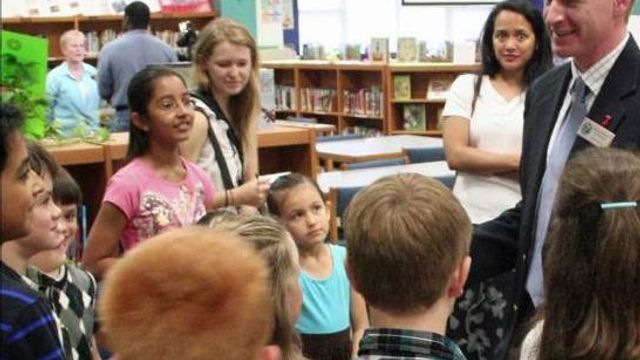Apex students talk with space station
Students at Salem Elementary in Apex connected with astronauts aboard the International Space Station for a Q&A, capping a month of lessons about space.
Posted — UpdatedLast Wednesday, students at Salem Elementary in Apex came together in the school's multipurpose room for a once-in-a-lifetime event.
Fourteen students, six of them winners of the school's science fair a few weeks earlier, made their way onto the stage for their turn to ask a question of astronaut Don Pettit 241 miles up and on the other side of the Earth aboard the International Space Station.
Salem Elementary declared March 21 "International Space Station Day" and prepared for it with a month-long, school-wide educational effort across all subjects using educational resources provided by NASA as well as those conceived by Salem teachers. Primary grades read stories about living in space, researched the planets and focused on space-related vocabulary. Classes researched how the space program has contributed to science.
Students worked together to prepare questions for the event and a school-wide art contest was held to design a mission patch to commemorate the event. A banner with that design now hangs in the school gym among years of banners celebrating athletic achievements.
As students filed in, they watched videos of ISS astronauts doing experiments including one where an Angry Birds toy and a bungee cord demonstrated how trajectories are considered when putting satellites into orbit. Google Earth was used in a description of the technology being used to connect the school to a ham radio volunteer half a world away. This makeshift mission control then zoomed out to show a second-by-second update of the ISS's location as it sped along at 17,500 mph over the Indian Ocean. ARISS volunteers on the line reminded everyone that the contact, like others before it, was an experiment and the results won't be known until the experiment is run.
At 10:07 am EDT, the station came over the horizon of Southern Australia and ham radio volunteer Tony Huchison (callsign VK5ZAI) called out to callsign NA1SS. Everyone relaxed a little bit when Pettit (callsign KD5MDT) responded and students lined up to ask their questions one after another:
Surai (4th grade) asked, "What is the source of electricity on the ISS?" Pettit responded that eight giant solar panels, each over 100 feet long and nearly 40 feet wide, track the sun as the station orbits the Earth providing plenty of power.
Nalley (2nd grade): "What experiments are you working on now?" Medical experiments to see how muscles react to microgravity.
Kyler (2nd grade): "How do you exercise in space?" A special exercise bike, treadmill and weight lifting machine that mimics lifting weights on Earth.
Matthew (5th grade): "Are you growing anything on the ISS? If so, does going from dark to light so many times a day affect the plants?" I am growing a zucchini and it does seem to be affected by the 15 periods of dark to light each day, it will be interesting to see how this affects its growth.
Zachary (4th grade): "Is the ISS shielded from the radiation of a solar flare?" Earth's magnetic field provides protection from cosmic radiation.
Just nine minutes and 19 questions after it started, the ISS dipped below the horizon of the Pacific Ocean and the event was over. Students from the youngest kindergartener through the most seasoned 5th grader knew they'd experienced history at their school. Their teachers had made sure of it. Perhaps the most amazing thing of all wasn't all the technology that made the day possible or that it all worked when it was supposed to. It was that over 600 children, from 5-year-olds to tweens, were silent for nearly an hour in a crowded, stuffy gym.
Apex High principal Matthew Wight joked that he had come to "scout talent." At a reception after the event, Apex Mayor Keith Weatherly and NC Rep. Tom Murry talked with the students about the Q&A as well as their math and science studies. That reception, provided by PTA volunteers, featured Tang, moon pies, astronaut ice cream and fresh fruit including star fruit. The adults had to explain the significance of the Tang.
The experience made an impression on teachers and students alike.
Even the lunch ladies took a break from lunch preparations long enough to listen in. Grinning teachers high-fived exclaiming "that was so cool!" A few students were overheard in hallways saying "I want to be an astronaut" but more were saying "I want to be a scientist." That's why volunteers around the world had put their time and talents into making the day a reality.
Copyright 2024 by Capitol Broadcasting Company. All rights reserved. This material may not be published, broadcast, rewritten or redistributed.





